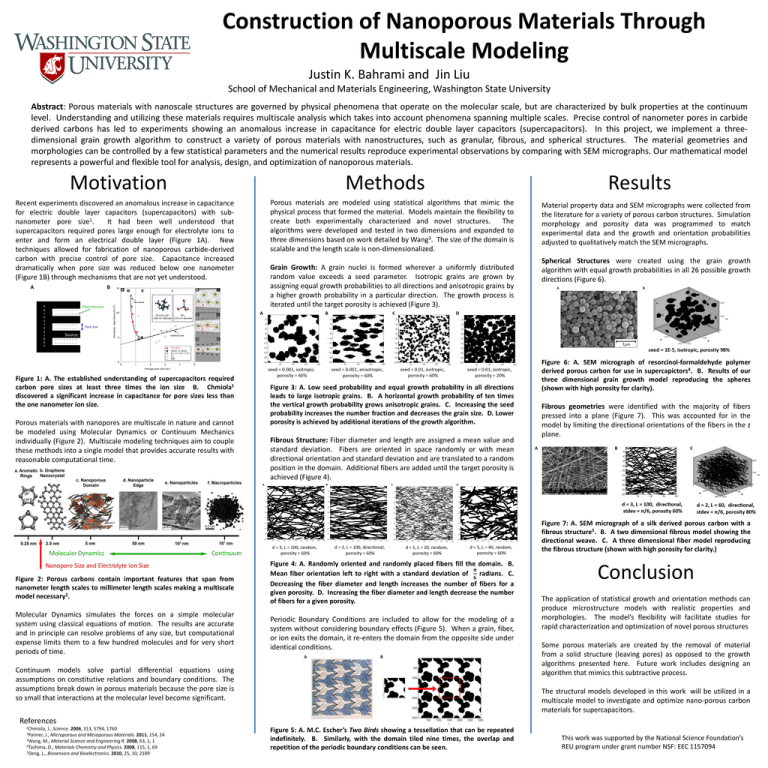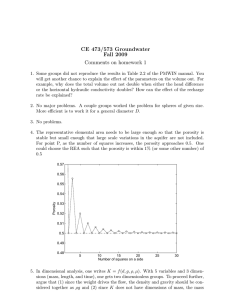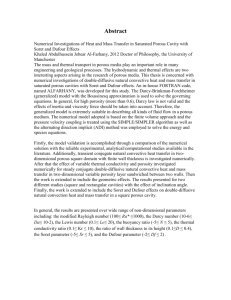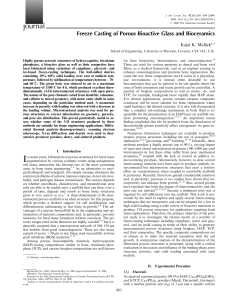Document 12005224
advertisement

Construction of Nanoporous Materials Through Multiscale Modeling Justin K. Bahrami and Jin Liu School of Mechanical and Materials Engineering, Washington State University Abstract: Porous materials with nanoscale structures are governed by physical phenomena that operate on the molecular scale, but are characterized by bulk properties at the continuum level. Understanding and utilizing these materials requires multiscale analysis which takes into account phenomena spanning multiple scales. Precise control of nanometer pores in carbide derived carbons has led to experiments showing an anomalous increase in capacitance for electric double layer capacitors (supercapacitors). In this project, we implement a threedimensional grain growth algorithm to construct a variety of porous materials with nanostructures, such as granular, fibrous, and spherical structures. The material geometries and morphologies can be controlled by a few statistical parameters and the numerical results reproduce experimental observations by comparing with SEM micrographs. Our mathematical model represents a powerful and flexible tool for analysis, design, and optimization of nanoporous materials. Motivation Recent experiments discovered an anomalous increase in capacitance for electric double layer capacitors (supercapacitors) with subnanometer pore size1. It had been well understood that supercapacitors required pores large enough for electrolyte ions to enter and form an electrical double layer (Figure 1A). New techniques allowed for fabrication of nanoporous carbide-derived carbon with precise control of pore size. Capacitance increased dramatically when pore size was reduced below one nanometer (Figure 1B) through mechanisms that are not yet understood. A B Methods Porous materials are modeled using statistical algorithms that mimic the physical process that formed the material. Models maintain the flexibility to create both experimentally characterized and novel structures. The algorithms were developed and tested in two dimensions and expanded to three dimensions based on work detailed by Wang3. The size of the domain is scalable and the length scale is non-dimensionalized. Grain Growth: A grain nuclei is formed wherever a uniformly distributed random value exceeds a seed parameter. Isotropic grains are grown by assigning equal growth probabilities to all directions and anisotropic grains by a higher growth probability in a particular direction. The growth process is iterated until the target porosity is achieved (Figure 3). Results Material property data and SEM micrographs were collected from the literature for a variety of porous carbon structures. Simulation morphology and porosity data was programmed to match experimental data and the growth and orientation probabilities adjusted to qualitatively match the SEM micrographs. Spherical Structures were created using the grain growth algorithm with equal growth probabilities in all 26 possible growth directions (Figure 6). Source: www.indoorskydiving.com Figure 1: A. The established understanding of supercapacitors required carbon pore sizes at least three times the ion size B. Chmiola1 discovered a significant increase in capacitance for pore sizes less than the one nanometer ion size. Porous materials with nanopores are multiscale in nature and cannot be modeled using Molecular Dynamics or Continuum Mechanics individually (Figure 2). Multiscale modeling techniques aim to couple these methods into a single model that provides accurate results with reasonable computational time. Figure 3: A. Low seed probability and equal growth probability in all directions leads to large isotropic grains. B. A horizontal growth probability of ten times the vertical growth probability grows anisotropic grains. C. Increasing the seed probability increases the number fraction and decreases the grain size. D. Lower porosity is achieved by additional iterations of the growth algorithm. Fibrous Structure: Fiber diameter and length are assigned a mean value and standard deviation. Fibers are oriented in space randomly or with mean directional orientation and standard deviation and are translated to a random position in the domain. Additional fibers are added until the target porosity is achieved (Figure 4). Figure 6: A. SEM micrograph of resorcinol-formaldehyde polymer derived porous carbon for use in supercapictors4. B. Results of our three dimensional grain growth model reproducing the spheres (shown with high porosity for clarity). Fibrous geometries were identified with the majority of fibers pressed into a plane (Figure 7). This was accounted for in the model by limiting the directional orientations of the fibers in the z plane. Figure 7: A. SEM micrograph of a silk derived porous carbon with a fibrous structure5. B. A two dimensional fibrous model showing the directional weave. C. A three dimensional fiber model reproducing the fibrous structure (shown with high porosity for clarity.) Figure 2: Porous carbons contain important features that span from nanometer length scales to millimeter length scales making a multiscale model necessary2. Molecular Dynamics simulates the forces on a simple molecular system using classical equations of motion. The results are accurate and in principle can resolve problems of any size, but computational expense limits them to a few hundred molecules and for very short periods of time. Figure 4: A. Randomly oriented and randomly placed fibers fill the domain. B. 𝝅 Mean fiber orientation left to right with a standard deviation of radians. C. 𝟔 Decreasing the fiber diameter and length increases the number of fibers for a given porosity. D. Increasing the fiber diameter and length decrease the number of fibers for a given porosity. Periodic Boundary Conditions are included to allow for the modeling of a system without considering boundary effects (Figure 5). When a grain, fiber, or ion exits the domain, it re-enters the domain from the opposite side under identical conditions. Continuum models solve partial differential equations using assumptions on constitutive relations and boundary conditions. The assumptions break down in porous materials because the pore size is so small that interactions at the molecular level become significant. Conclusion The application of statistical growth and orientation methods can produce microstructure models with realistic properties and morphologies. The model’s flexibility will facilitate studies for rapid characterization and optimization of novel porous structures Some porous materials are created by the removal of material from a solid structure (leaving pores) as opposed to the growth algorithms presented here. Future work includes designing an algorithm that mimics this subtractive process. The structural models developed in this work will be utilized in a multiscale model to investigate and optimize nano-porous carbon materials for supercapacitors. References 1Chmiola, J., Science. 2006, 313, 5794, 1760 2Palmer, J., Microporous and Mesoporous Materials. 2011, 154, 24 3Wang, M., Material Science and Engineering R. 2008, 63, 1, 1 4Tashima, D., Materials Chemistry and Physics. 2008, 115, 1, 69 5Deng, L., Biosensors and Bioelectronics. 2010, 25, 10, 2189 Figure 5: A. M.C. Escher’s Two Birds showing a tessellation that can be repeated indefinitely. B. Similarly, with the domain tiled nine times, the overlap and repetition of the periodic boundary conditions can be seen. This work was supported by the National Science Foundation’s REU program under grant number NSF: EEC 1157094






